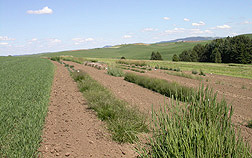This page has been archived and is being provided for reference purposes only. The page is no longer being updated, and therefore, links on the page may be invalid.
| Read the magazine story to find out more. |
|
|
|
|
Grass Germplasm Collection Also Includes Fungal Endophytes
By Jan SuszkiwJanuary 27, 2011
One of the world's largest collections of cool-season forage and turf grasses is located at the Western Regional Plant Introduction Station (WRPIS), operated in Pullman, Wash., by the U.S. Department of Agriculture (USDA).
It could also be said that the station is, by default, among the largest collections of endophytes, a specialized group of Neotyphodium fungi that live symbiotically within the tissues of certain grasses—tall fescue among them.
The endophytes' presence can be a mixed bag, however. On the one hand, they help their grass hosts tolerate stresses like drought and they produce metabolites that repel insect pests. But some of the metabolites—notably, ergot alkaloids—can cause fescue toxicosis in grazing livestock.
Fortunately, intensive research over the past several years has identified new endophyte strains that don't cause fescue toxicosis, but that still confer desirable benefits to grass.
According to Stephen Clement, who recently retired as an entomologist with USDA's Agricultural Research Service (ARS) in Pullman, research organizations in the United States and abroad are increasingly mining the WRPIS collection to identify new strains of these nontoxigenic endophytes. ARS is USDA's principal intramural scientific research agency, and this research supports the USDA priority of promoting international food security.
Mindful of the interest in the collection, Clement and colleagues with the ARS Forage Seed and Cereal Research Unit in Corvallis, Ore., conducted research to ensure that the station's current seed regeneration practices are suitable for maintaining viable stores of the endophytes.
Clement had been conducting studies to better characterize the diverse grass-endophyte associations in the collection and to determine what effect this has on feeding by insect pests. In recent research, Clement observed a decline in the survival of cereal leaf beetles—invasive pests of Pacific Northwest seed nurseries—that fed on endophyte-infected grasses, including the wild tall fescue Lolium arundinaceum.
Read more about this research in the January 2011 issue of Agricultural Research magazine.

